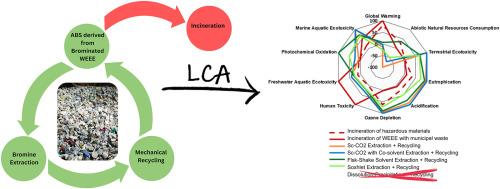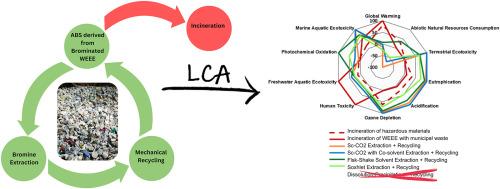Life cycle analysis of mechanical recycling vs. conventional incineration for brominated acrylonitrile butadiene styrene (ABS) derived from WEEE
IF 7.3
2区 环境科学与生态学
Q1 ENVIRONMENTAL SCIENCES
引用次数: 0
Abstract
This study provides the first comprehensive life cycle assessment (LCA) comparing pre-mechanical recycling methods for acrylonitrile butadiene styrene (ABS) from waste electrical and electronic equipment (WEEE) containing restricted brominated flame retardants (BFRs). By evaluating the environmental impacts of BFR extraction techniques, this research addresses a critical gap in prior studies that predominantly focused on extraction efficiency. This research identifies BFR removal, required for compliance with EU Regulation 2019/1021, as the most environmentally impactful stage of the recycling process. While ABS recycling was found to offset 60–100 % of environmental impacts compared to virgin production, particularly in resource consumption and global warming, energy consumption emerged as a key factor influencing environmental performance across most extraction methods. Among the techniques analyzed, Soxhlet extraction exhibited the lowest environmental impact, followed by supercritical CO2 and flask-shake solvent extractions. In contrast, the dissolution-precipitation method demonstrated a significantly higher environmental footprint due to its reliance on organic solvents, which contribute 80–90 % of impact categories such as greenhouse gases (GHG) emissions (19.69 kg CO2 eq.) despite the high solvent recycling efficiency of 80 %. The findings also revealed that mechanical recycling, when combined with extraction techniques, is more environmentally favorable than incineration in terms of abiotic resource depletion. Nonetheless, incineration remains the most viable option when considering overall environmental performance metrics. This study underscores the urgent need for BFR extraction optimization to enhance the sustainability of brominated plastic WEEE mechanical recycling.


报废电子电气设备产生的溴化丙烯腈-丁二烯-苯乙烯(ABS)的机械回收与传统焚烧的生命周期分析
本研究首次对含有受限溴化阻燃剂(BFRs)的废旧电气电子设备(WEEE)中丙烯腈-丁二烯-苯乙烯(ABS)的预机械回收方法进行了综合生命周期评估(LCA)。通过评估BFR提取技术对环境的影响,本研究解决了先前主要关注提取效率的研究中的一个关键空白。这项研究确定了BFR的去除是回收过程中对环境影响最大的阶段,这是符合欧盟法规2019/1021的要求。虽然与原始生产相比,ABS回收可以抵消60-100%的环境影响,特别是在资源消耗和全球变暖方面,但能源消耗已成为影响大多数提取方法环境绩效的关键因素。其中,索氏提取法对环境影响最小,其次是超临界CO2萃取法和摇瓶溶剂萃取法。相比之下,由于对有机溶剂的依赖,溶解-沉淀法显示出更高的环境足迹,尽管溶剂回收效率高达80%,但有机溶剂占温室气体(GHG)排放(19.69 kg CO2当量)等影响类别的80-90%。研究结果还表明,在消耗非生物资源方面,机械回收与提取技术相结合,比焚烧更环保。尽管如此,考虑到整体环境绩效指标,焚烧仍然是最可行的选择。本研究强调了优化BFR提取以提高溴化塑料WEEE机械回收的可持续性的迫切需要。
本文章由计算机程序翻译,如有差异,请以英文原文为准。
求助全文
约1分钟内获得全文
求助全文
来源期刊

Environmental Pollution
环境科学-环境科学
CiteScore
16.00
自引率
6.70%
发文量
2082
审稿时长
2.9 months
期刊介绍:
Environmental Pollution is an international peer-reviewed journal that publishes high-quality research papers and review articles covering all aspects of environmental pollution and its impacts on ecosystems and human health.
Subject areas include, but are not limited to:
• Sources and occurrences of pollutants that are clearly defined and measured in environmental compartments, food and food-related items, and human bodies;
• Interlinks between contaminant exposure and biological, ecological, and human health effects, including those of climate change;
• Contaminants of emerging concerns (including but not limited to antibiotic resistant microorganisms or genes, microplastics/nanoplastics, electronic wastes, light, and noise) and/or their biological, ecological, or human health effects;
• Laboratory and field studies on the remediation/mitigation of environmental pollution via new techniques and with clear links to biological, ecological, or human health effects;
• Modeling of pollution processes, patterns, or trends that is of clear environmental and/or human health interest;
• New techniques that measure and examine environmental occurrences, transport, behavior, and effects of pollutants within the environment or the laboratory, provided that they can be clearly used to address problems within regional or global environmental compartments.
 求助内容:
求助内容: 应助结果提醒方式:
应助结果提醒方式:


